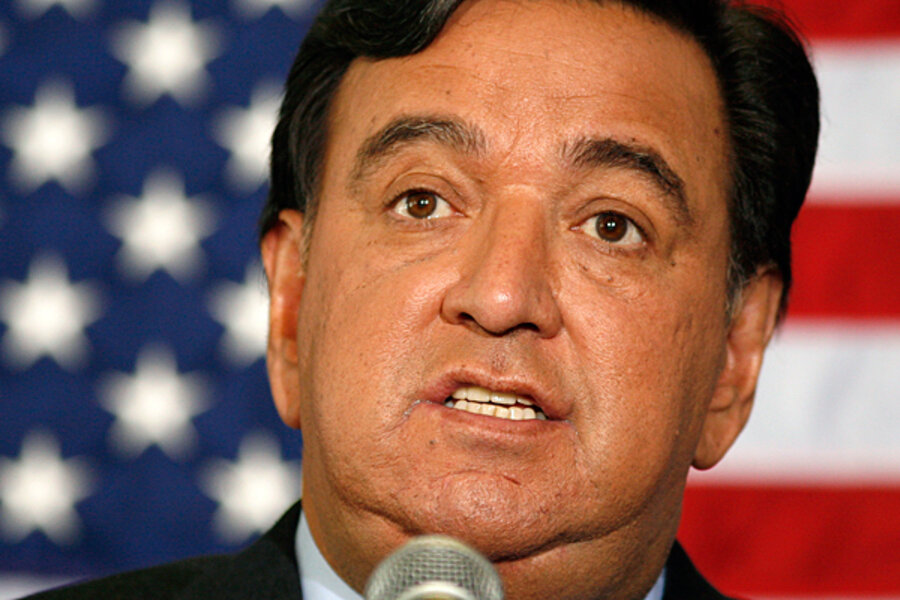North Korea invites Bill Richardson to visit: What message is it sending?
Loading...
| Washington
New Mexico Governor Bill Richardson’s trip to North Korea next week has all the hallmarks of an effort by Pyongyang to step back from confrontation in the region that could also yield valuable information on conditions inside the closed state and the mercurial regime’s thinking.
While Governor Richardson, a former presidential candidate and US ambassador to the United Nations in the Clinton administration, was invited to North Korea by the country’s top nuclear negotiator, the US took pains this week to say the visit was not official US government business. Yet such unofficial visits have been useful to the North to send out diplomatic signals, and visiting Americans routinely brief US officials upon their return.
Given the current context of heightened tensions between the two Koreas, information provided to the North Koreans or gleaned from their conversation can be an important means of reversing “crisis escalation,” says one US expert who has had similar private conversations with the North Koreans on their territory in the past.
“Anything you can do to reduce misperception and miscalculation helps prevent war,” says Jim Walsh, a professor of security studies at the Massachusetts Institute of Technology in Cambridge, Mass., who visited North Korea in 2005 for a lengthy “private conversation.”
Such visits can deliver insight into the North’s motivations in the absence of a diplomatic dialogue, he says, while providing the North Koreans with a realistic if unofficial description of US positions.
Tensions have soared in the region since North Korea spurred an exchange of artillery with the South in late November by shelling an island along the two countries' disputed sea border. The incident was regarded as the worst in the region since the end of the Korean War.
Richardson’s office announced this week that he would leave Dec. 14 on a seven-day trip to North Korea, at the invitation of the North’s chief nuclear negotiator, Kim Gye Gwan. Richardson, who is no stranger to the North Koreans, said in a statement, “I am increasingly concerned with the recent actions by the North Koreans, which have raised tensions and are contributing to instability on the Korean Peninsula.”
Richardson’s last trip to Pyongyang was in 2007, when he returned with the remains of US servicemen killed in the Korean War.
The State Department was emphatic this week that Richardson’s visit in no way constitutes US government business, underscoring the US position that official diplomatic engagement with the North will only resume once the North’s provocations cease and it recommits to serious negotiations on its nuclear program.
But at the same time, officials say they expect the usual pattern of “high-level visitors” to the North reporting back to Washington to be followed in this case.
“President Carter … debriefed the secretary [of State] in the aftermath of his visit,” said State Department spokesman P.J. Crowley this week. “I would expect Governor Richardson to report back after he’s done,” he said, adding that the governor “will not be carrying a message from the United States Government.”
MIT’s Professor Walsh says the North Koreans have often used such private visits to divulge information they want to get out. For example, last month Stanford University Prof. Siegfried Hecker reported on a tour he was given of a secret and previously undisclosed uranium enrichment facility at the North’s Yongbyon nuclear complex. That disclosure was widely interpreted as an attempt by the North to convince the US of the urgency of returning to dialogue.
During his 2005 visit, Walsh says the North Koreans told him of their willingness to return to the Nuclear Non-Proliferation Treaty.
In the past, the North Koreans seem to have invited a “flurry of visitors” in anticipation of a return to the so-called six-party talks involving the two Koreas, the US, China, Russia, and Japan, and focused on the North’s nuclear program, Walsh says. Either that, or the visits have signaled “the beginning of a return to reaching out to the outside world,” he says.
“On the face of it, this doesn’t appear to fit that pattern,” Walsh says, given the North’s shelling of a South Korean island last month. But he adds that North Korean officials may have “made the calculation that, at the end of the day, the other countries will say, what else can we do” but return to dialogue?
The Richardson visit may be their way of testing their own speculation.





